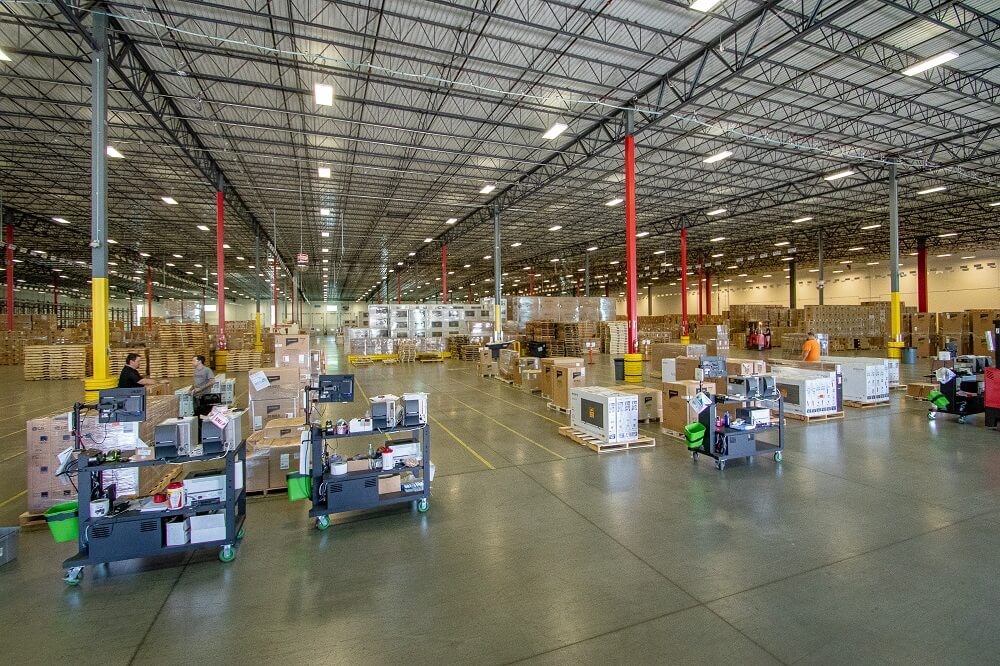The Top 4 Challenges for
Depot Repair Service Management
and How to Solve Them
Managing your depot repair services can feel like playing a game of Jenga — one wrong move, and your entire process comes crashing down. Companies that supply high-tech equipment carry a heavy responsibility for keeping products operating effectively throughout their lifecycle.
However, most technology products develop faults at some point and need repair. Many suppliers find it difficult to manage this non-core activity in-house, but outsourcing depot repair service management offers a viable solution.
1What is Depot Repair Service Management?
What is depot repair service management and what is its purpose?
2What Are The Top 4 Depot Repair Service Management Challenges?
A depot repair strategy can enhance service efficiency, reduce downtime and improve profitability, but it's not without its challenges
3What Are the Benefits of Building vs. Outsourcing Depot Repair Services?
Choosing whether to build your own depot repair services infrastructure or to outsource this function to a partner is a critical decision
4What Should You Look for in a Depot Repair Service Management Partner?
There are several key qualities to consider when you’re looking for a depot repair service management partner — here are just a few
5The Final Analysis: Outsourcing Depot Repair Service Management to an Experienced Partner
Give your customers what they're asking for — and more — with a timeless, customer-driven depot repair services strategy
What is Depot Repair Service Management?
Depot repair service management typically encompasses a range of capabilities and support services for field-based products, parts and components. Depot repair services serve to extend both product lifetime and customer value by keeping your products in your customers’ hands, working as intended for as long as possible. Managing the depot repair process involves several functions, such as:
- Coordinating the logistics and scheduling of equipment repairs
- Managing repair contracts and associated customer service
- Overseeing inventory management and warehouse operations
- Tracking repair progress to ensure timely completion
As part of this service management function, your company must prioritize customer satisfaction by providing responsive, reliable, high-quality repair services. Doing so empowers you to retain market trust, improve product reliability, minimize your carbon footprint and reduce the costs associated with equipment downtime.
What Are The Top 4 Depot Repair Service Management Challenges?
Many technology companies reactively develop a depot repair strategy on an as-needed basis. Despite the rise in cloud-based applications, companies still need onsite hardware to be able to run their operations. Research shows that 70% of companies lack awareness of when their equipment assets are due for maintenance or upgrade, which can lead to unplanned downtime and business disruption. Instead, proactively implementing a well-designed depot repair strategy can enhance service efficiency, reduce downtime and improve profitability. However, this approach is not without its challenges:
1. Lack of Repair Status Visibility
Not knowing the status of technology products in the depot repair process can lead to an array of issues, such as:
- Delays in repair times, which is especially problematic for customers with urgent repair needs
- Difficulty prioritizing, tracking and managing repair progress
- Challenges in identifying bottlenecks or potential improvement areas across the process
These factors often result in increased costs, reduced productivity and missed opportunities for customer satisfaction and process optimization — all of which impact your profit margins.
2. Rapid Industry Change and Evolving Customer Expectations
Technological advancements are happening faster than ever, and your customers’ expectations are changing equally rapidly. Your organization must adapt to new business models and market dynamics to keep up with trends and developments. You must also provide innovative solutions, including the rise of cloud-based services and the increasing demand for subscription-based pricing models. On top of this, with so much attention on the growing demands for new innovations, it can be difficult to find the right balance in properly maintaining and repairing your other technologies and legacy products for customers.
3. Unpredictable, Unreliable Logistics Networks
Unpredictability and unreliability in logistics networks can equate to significant and dire process gaps for technology manufacturers. Variables outside your control, such as political action, weather disruptions, transportation delays and supplier performance issues, can severely impact your supply chain. Further, poor communication and coordination between multiple partners and service providers also contribute to unpredictability, making planning and managing logistics a challenge.
4. Reduced Customer Retention
Your customers expect prompt, timely and responsive repair services that quickly get your products back into their hands. If your company fails to deliver on these fronts, customers will likely move on and engage with your competition for comparable products. Or they may take your products to unauthorized third-party repair providers, not realizing that the quality of repair isn’t up to your company’s standards. Either of these alternatives can damage your brand reputation.
These four factors make depot repair service management a complex and challenging activity for any company whose core business is technology production and innovation.
What Are the Benefits of Building vs. Outsourcing Depot Repair Services?
Choosing whether to build your own depot repair services infrastructure or to outsource this function to a partner is a critical decision for technology manufacturers. Building has definite advantages, but these are offset by some unique challenges.
Building Your Own Depot Repair Services Infrastructure
Establishing your own depot repair services means you have full control and ownership, with room for greater flexibility to adjust repair services as business needs evolve. You can ensure your services meet customer needs and requirements and that repairs are completed based on the specifications of your unique products.
However, it can be costly and time-consuming to build and maintain everything that goes into standing up your own depot repair services infrastructure, including the physical repair facility and the necessary equipment, personnel and processes to successfully support and execute your repair services. Building your own infrastructure requires careful consideration of the costs and resources, potential trade-offs, significant capital investment and ongoing operational expenses.
Additionally, building a depot repair service facility can increase your carbon footprint. For instance, having a facility that isn’t strategically located near your customers or key transportation hubs can mean higher costs and emissions associated with transportation. And space optimization is important for sustainability, too, as an inefficient facility layout can lead to poor inventory management and unnecessary material movements, increasing the energy required to shift products through the facility.
Finally, launching an internal depot repair service can distract your teams’ attention from core activities, such as customer acquisition and retention, research and development, sales, marketing and customer service. It can also create capacity constraints that limit your company's ability to provide adequate repair services for legacy products while innovating new technologies.
Outsourcing Depot Repair Service Management 
Outsourcing your depot repair service management operations affords multiple advantages over building the infrastructure yourself, including the ability to:
- Leverage the best practices and expertise of experienced technicians and repair professionals without increasing your headcount and related recruitment, hiring and training costs
- Access a broader range of depot repair services, including support for legacy products as well as the latest technologies
- Enjoy greater flexibility and scalability, which allows you to adjust your repair services as business and customer needs change
- Expand your geographic footprint and utilize already-established, secure, certified facilities
- Bolster your dedication to sustainability and participation in the circular economy
All of this means:
- Reduced requirement to manage premises and personnel
- No need for significant capital investments or operational expenses
- Fewer distractions from your core business activities
What Should You Look for in a Depot Repair Service Management Partner?
When you’re looking for a depot repair service management partner, there are several key qualities to consider. For starters, you want to make sure you partner with a company that holds itself to the same high standards as yours to ensure ongoing customer success and satisfaction. Consider the following when assessing a potential depot repair partner:
 A Consistent, Reliable and Timely Experience for Customers
A Consistent, Reliable and Timely Experience for Customers
Reliability and consistency require a commitment to service excellence, robust quality control processes and effective communication and collaboration throughout the repair process.
 Prioritization of Sustainability-Driven Initiatives and Support for the Circular Economy
Prioritization of Sustainability-Driven Initiatives and Support for the Circular Economy
Supporting the circular economy includes minimizing waste, reducing energy consumption and promoting the responsible disposal and recycling of end-of-life products.
 Robust Root Cause Analysis Capabilities
Robust Root Cause Analysis Capabilities
Reliability and consistency require a commitment to service excellence, robust quality control processes and effective communication and collaboration throughout the repair process.
 The Ability to Navigate Industry Change and Disruption
The Ability to Navigate Industry Change and Disruption
A partner with this experience provides the insight, guidance and expertise needed to close operational gaps and ensure your repair services remain competitive and relevant in a rapidly evolving marketplace.
 Competence to Support a Variety of Verticals
Competence to Support a Variety of Verticals
Technology and devices are abundant in innumerable verticals, including the medical field, broadband solutions and more. A depot repair facility therefore requires a broad range of technical expertise and repair capabilities, as well as a profound understanding of each vertical’s unique challenges and requirements.
 Comprehensive Repair Capabilities
Comprehensive Repair Capabilities
A comprehensive repair solution can include reverse engineering, component-level repair, failure and root cause analysis, program management and reporting, spare parts planning, returns management, quality testing, logistics management and the ability to repair a wide range of products, components and parts, ranging from data centers to clients and specialty embedded technologies.
 Enhanced Visibility Throughout the Repair Process
Enhanced Visibility Throughout the Repair Process
Achieving enhanced visibility requires a robust global shop floor control system that provides data and real-time information on the status of repairs and the location of products throughout the supply chain. Benefits of this type of system include:
- Access to accurate and timely information anytime, anywhere, on a global scale
- Flexibility to incorporate custom add-ons as needed
- Improved inventory management to support sustainability
- A centralized data repository to streamline operations across multiple locations
- Data-driven inventory planning for efficient replenishment
 A Complete End-to-End Logistics Solution
A Complete End-to-End Logistics Solution
Go beyond depot repair services to consider the full lifecycle of your product with a single partner who can cover your technology from beginning to end and keep your customers up and running smoothly.
The Final Analysis: Outsourcing Depot Repair Service Management to an Experienced Partner
Managing depot repair services is challenging for technology companies wanting to maintain high-quality service levels and customer satisfaction, while simultaneously optimizing costs and resource allocation. Proactively implementing a well-designed depot repair strategy is critical to enhancing service efficiency, reducing downtime and improving profitability.
When you’re considering how to offer the best depot repair service solution, keep in mind that outsourcing those operations offers multiple advantages over developing an in-house infrastructure. These benefits include leveraging the expertise of experienced technicians, greater flexibility and scalability as well as fewer distractions from your core business activities.
When choosing the right depot repair service management partner, look for key qualities such as service excellence, a commitment to sustainability and the experience to navigate change. Industry knowledge, comprehensive repair capabilities, enhanced visibility and a complete end-to-end logistics solution will deliver the services you and your customers need with the quality that matches your standards. By partnering with the right service provider, you can maintain your customers' trust, improve product reliability and keep your business moving forward.
Give your customers what they're asking for — and more — with a timeless, customer-driven depot repair services strategy.










